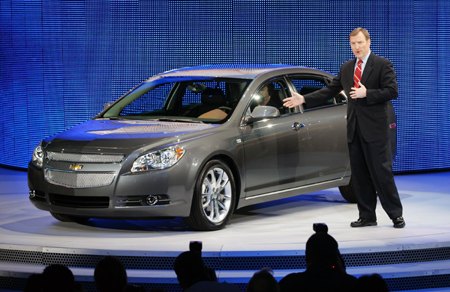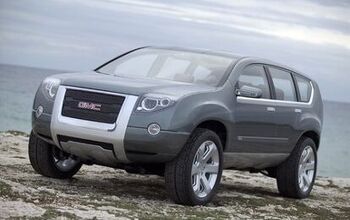General Motors Death Watch 138: The Big Picture
"We anticipate [that the U.S.] will still be the most profitable market in the decade ahead. It's really key not to be excessively dependent on the U.S., but you still need to be successful in the U.S." It’s no surprise that GM Chief Sales Analyst Paul Ballew sent mixed messages to the financial community when revealing GM’s Q2 sales results. Not to put too fine a point on it, the automaker’s U.S. market share continues to evaporate while its overseas operations continue to expand. The General’s growing foreign sales aren’t enough to compensate for the company’s North American sinkhole, but it gave GM’s spinmeister something to spin. Such is the way of things at GM these days.
That said, this just in: according to Mr. Ballew, GM should begin seeing a recovery in U.S. in 2008. As far as I can tell, no reporter or analyst asked GM’s mouthpiece what events or non-events are covered by the word “should,” what exactly the word “recovery” means, when in 2008 this recovery will arrive or how this sudden rise from GM’s fall from grace will be achieved. Oh, and didn’t GM say they were already in recovery?
Yes, well, it’s no wonder GM’s backed away from that idea. Thanks to a spectacularly lousy June, this financial quarter, at the height of GM’s new product cadence, the automaker’s North America sales fell seven percent. Once again, GM blamed high gasoline prices, a weak housing market and a planned reduction in daily rental sales. So are we to assume that gas prices will decline, the housing market will jump to its feet and the company will abandon abandoning daily rental sales?
The last point raises an important question. It’s all well and good to bolster residual values by limiting fleets sales, but what will take the place of these job lots and raise GM NA out of its current torpor? The new Saturn Astra, whose production and importation costs obviate the possibility of profit? The new Chevrolet Yukon hybrid, an enigma wrapped in a riddle (what kind of fuel conscious buyer buys a huge, poorly packaged SUV)?
How about the new Chevrolet Malibu? Last year, the current fleet queen Malibu racked-up 153,846 sales. If GM is getting out of the fleet business, they’ll need to replace every Malibu removed from fleet duty with one purchased by a retail customer. In other words, Chevrolet will have to sell tens of thousands more Malibus to retail customers just to achieve existing volumes.
The redesigned Cadillac CTS is also on the horizon. Last year, GM’s erstwhile luxury division unloaded 54,846 CTS sedans on its class-conscious customers. Even if Caddy doubles that total, it still wouldn’t generate anywhere near enough profit to rescue a company with eight brands selling 52 models.
Clearly, obviously, GM’s turnaround depends on the company shifting a lot more of everything. While there are some bright spots and heavy hitters in GM’s roster– the law of averages guarantees it– the overall picture is bleak. Other than reducing price, which kills profits and destroys brand equity, what can they do?
Rick Wagoner’s mob doesn’t have an answer. Thankfully (for them), no one’s asking. All eyes are now upon GM’s negotiations with the United Auto Workers (UAW). Wall Street, stockholders and GM camp followers are all watching the proceedings like hawks, presuming that reducing labor costs to transplant parity is the key to GM’s survival. That logic only works if you assume that GM would use the money saved to make better cars. Is there anyone out there who really believes that?
At the risk of sounding cynical (perish the thought), any money saved is likely to disappear down GM’s corporate rat hole. For one thing, if GM bosses pay themselves huge bonuses when the company’s losing billions, imagine what they’ll do after concluding a “historic union giveback.”
Whether or not GM “reduces” its health care obligations by going into subterranean levels of debt (to set up a VEBA for the UAW as described by Frank Williams), whether or not the two sides emerge from negotiations with the status quo intact or destroyed, Chevy and Saturn will still be fighting a losing battle against Toyondissan, Cadillac will still be struggling for sales, Pontiac and Buick will still be deeply damaged brands, Hummer and Saab will still be expensive irrelevances and GMC will still be… there.
Now that GM’s suffered a 24 percent sales drop in June against the transplants’ double digit sales increases, some analysts are beginning to understand the crux of GM’s problem: unloved, unwanted and uncompetitive product. If GM’s sales take another big hit in July while their competition moves upward, there will be even more pressure to do a deal with the UAW. And it will be even more irrelevant.
More by Robert Farago
Latest Car Reviews
Read moreLatest Product Reviews
Read moreRecent Comments
- Yuda I'd love to see what Hennessy does with this one GAWD
- Lorenzo I just noticed the 1954 Ford Customline V8 has the same exterior dimensions, but better legroom, shoulder room, hip room, a V8 engine, and a trunk lid. It sold, with Fordomatic, for $21,500, inflation adjusted.
- Lorenzo They won't be sold just in Beverly Hills - there's a Nieman-Marcus in nearly every big city. When they're finally junked, the transfer case will be first to be salvaged, since it'll be unused.
- Ltcmgm78 Just what we need to do: add more EVs that require a charging station! We own a Volt. We charge at home. We bought the Volt off-lease. We're retired and can do all our daily errands without burning any gasoline. For us this works, but we no longer have a work commute.
- Michael S6 Given the choice between the Hornet R/T and the Alfa, I'd pick an Uber.


































Comments
Join the conversation
As a Service Advisor at a large Chevrolet dealership, I can see why GM is in such trouble. While the drivetrains are adequate, the interior trim and electronic devices are the absolute worst quality. GM should be ashamed of the product that they peddle to the American public. I currently in the market for a new vehicle and there is no way I would consider purchasing a GM (or any other domestic) vehicle. It's a sad state of affairs that the American manufacturers can't produce a quality vehicle. But, I guess that I shouldn't complain about the quality because that is how I make a fat living fixing Detroit's junk.
"Can anyone tell me why GMC exists? What message does it send? Why would I buy a GMC truck over a Chevvy truck?" The same could be said, "why is there a Chevy Truck ? Wouldn't make more sense to get Chevrolet OUT OF THE TRUCK MARKET? Merge Chevy and GMC together, have Chevy the car line and GMC the Truck division? That is what GMC was originally for ! Besides, IMO GMC is a better quality vehicle then Chevy. Chevy has a rep of being cheap. Why not use it to GM's advantage? Then close Buick, SAAB and Hummer (leave the first two overseas, kill Hummer). You could even go as far as killing Pontiac In the end you would have a three/four division company: Chevy/GMC - Affordable & truck division (i.e. Toyota) Cadillac - Luxury (i.e. Lexus) Personnally, I have higher doubts of Ford's survival then GM's. GM is making money overseas, while Ford is not. Besides, Ford just got started on the "revival". It will be at least another two years before Ford is on the upswing, if at all.